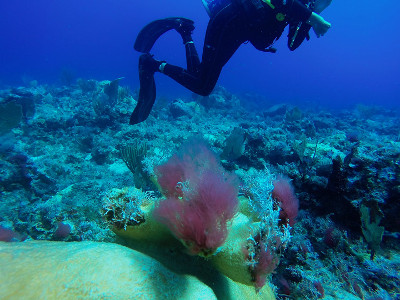 COLE BAY:--- The St. Maarten Nature Foundation has been continuously monitoring the reefs for their health and to assess the underwater damage caused by Hurricane Irma. During the reef surveys held at the beginning of November, several shallower dive sites started to show a worrisome outbreak of red algae species. Especially on reefs shallower than 35 feet in depth large red algae blooms were recorded in the Marine Park and on other reefs around the island.
COLE BAY:--- The St. Maarten Nature Foundation has been continuously monitoring the reefs for their health and to assess the underwater damage caused by Hurricane Irma. During the reef surveys held at the beginning of November, several shallower dive sites started to show a worrisome outbreak of red algae species. Especially on reefs shallower than 35 feet in depth large red algae blooms were recorded in the Marine Park and on other reefs around the island.
Blooms of red algae can hamper the regrowth of several reef species which were damaged due to hurricane Irma’s swells. Red algae are strong competitors and their fast growth rate will leave no space for important reef builders such as corals and sponges to recover. Algae blooms can be an indicator for water quality, showing a decrease in the water quality on St Maarten reefs and surroundings. Certain red algae species can also be a health issue when very abundant and close to shore. The state of our reefs is especially now worrisome as already 50% of the reef has been damaged wby Hurricane Irma.
An outbreak of red algae is probably due to increased nutrients feeding the algae and causing it to bloom. Increased nutrient input could be associated with hurricane passage or due to pollution such as sewage outflow. High hurricane winds mix the ocean water bringing nutrients from the deep, at a time when warm summer water are often nutrient depleted. The nutrients spur algae to grow, creating large blooms of algae. However, the red algae outbreak could be also related to the recent pump out of the Great Salt Pond, causing polluted water with high nutrients to flow to our reefs.
The Nature Foundation would like to warn all people, businesses, and establishments to be sure no sewage flows are going into the ocean or lagoon to prevent further water deterioration.
Nature Foundation Press Release












